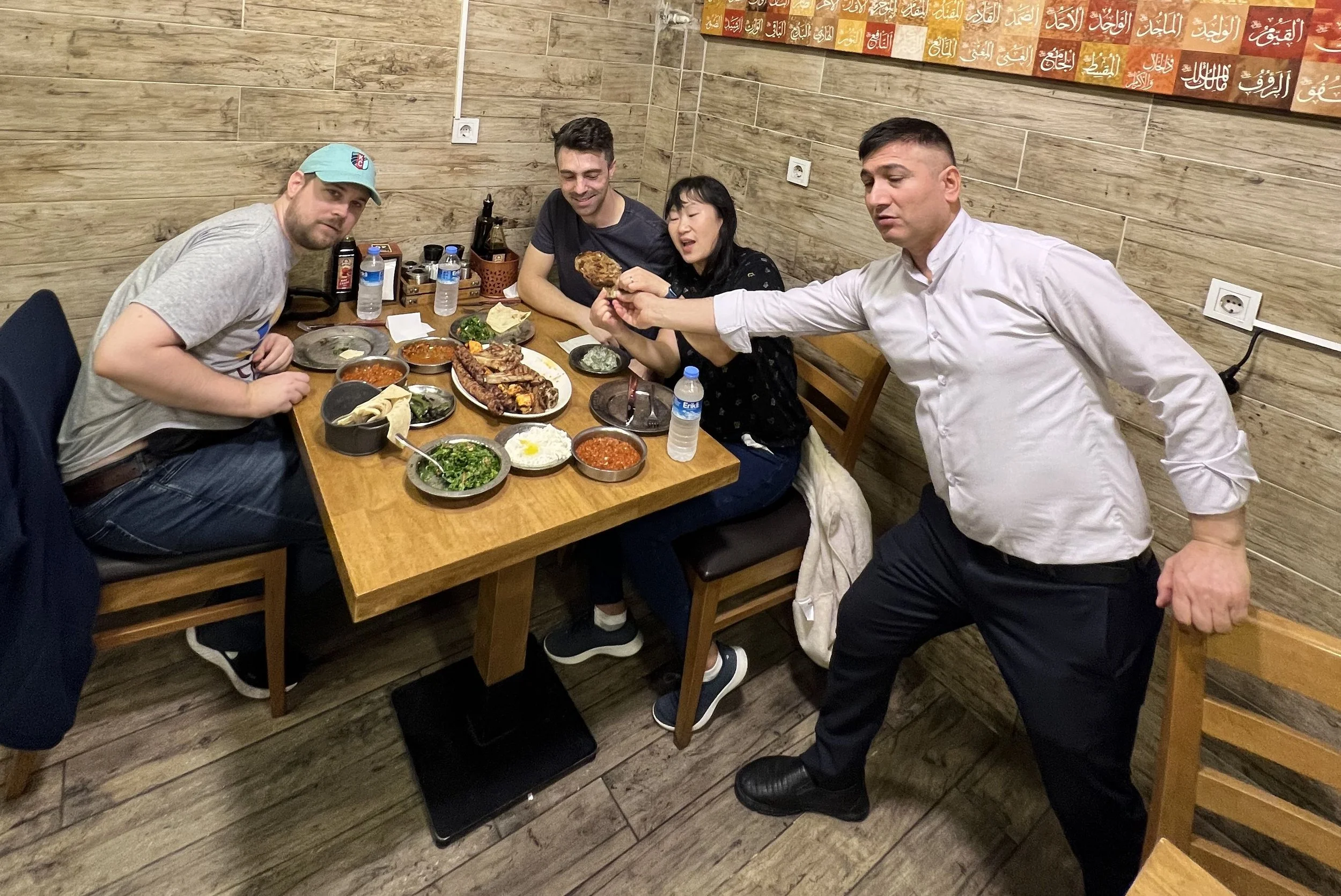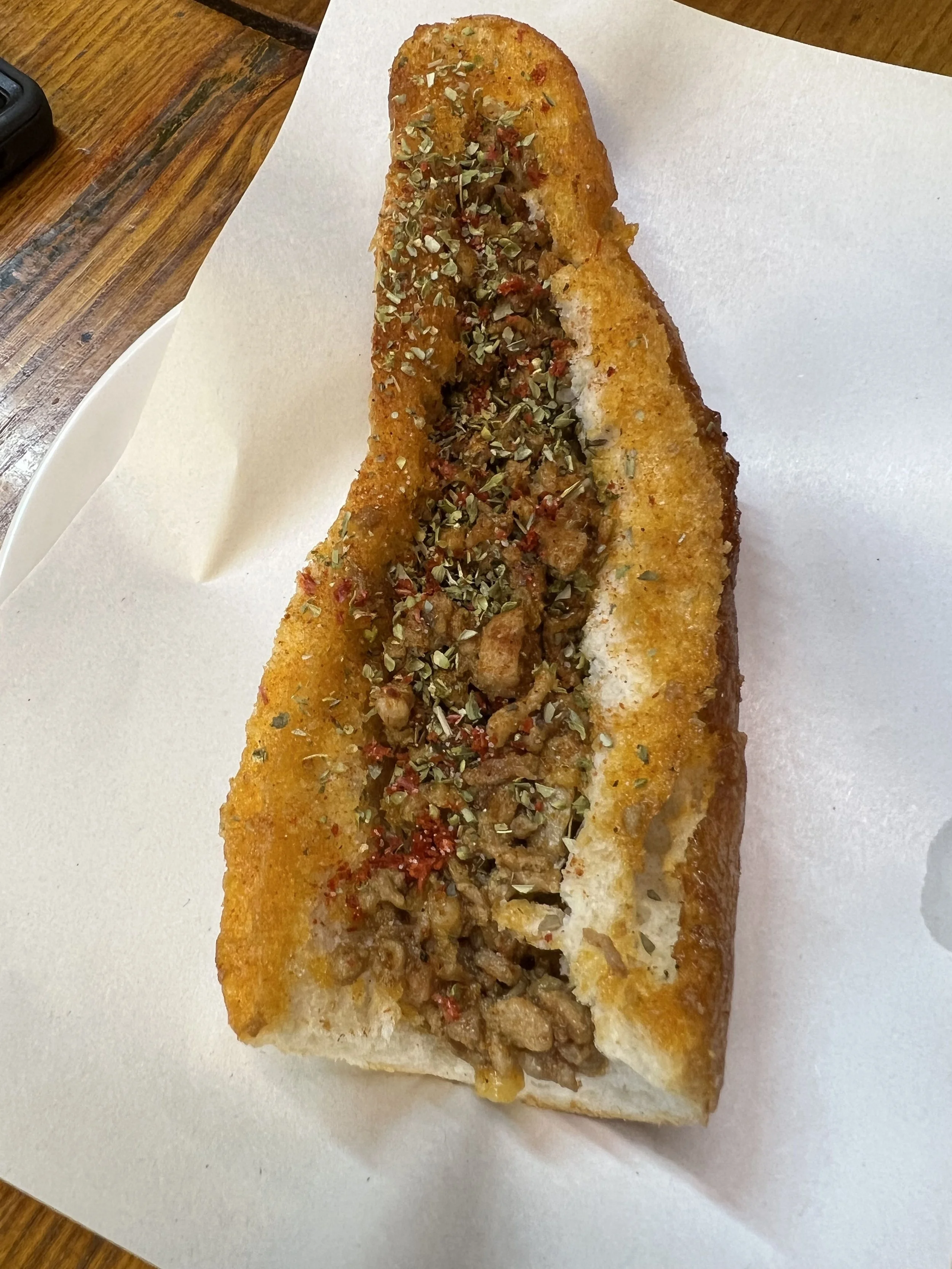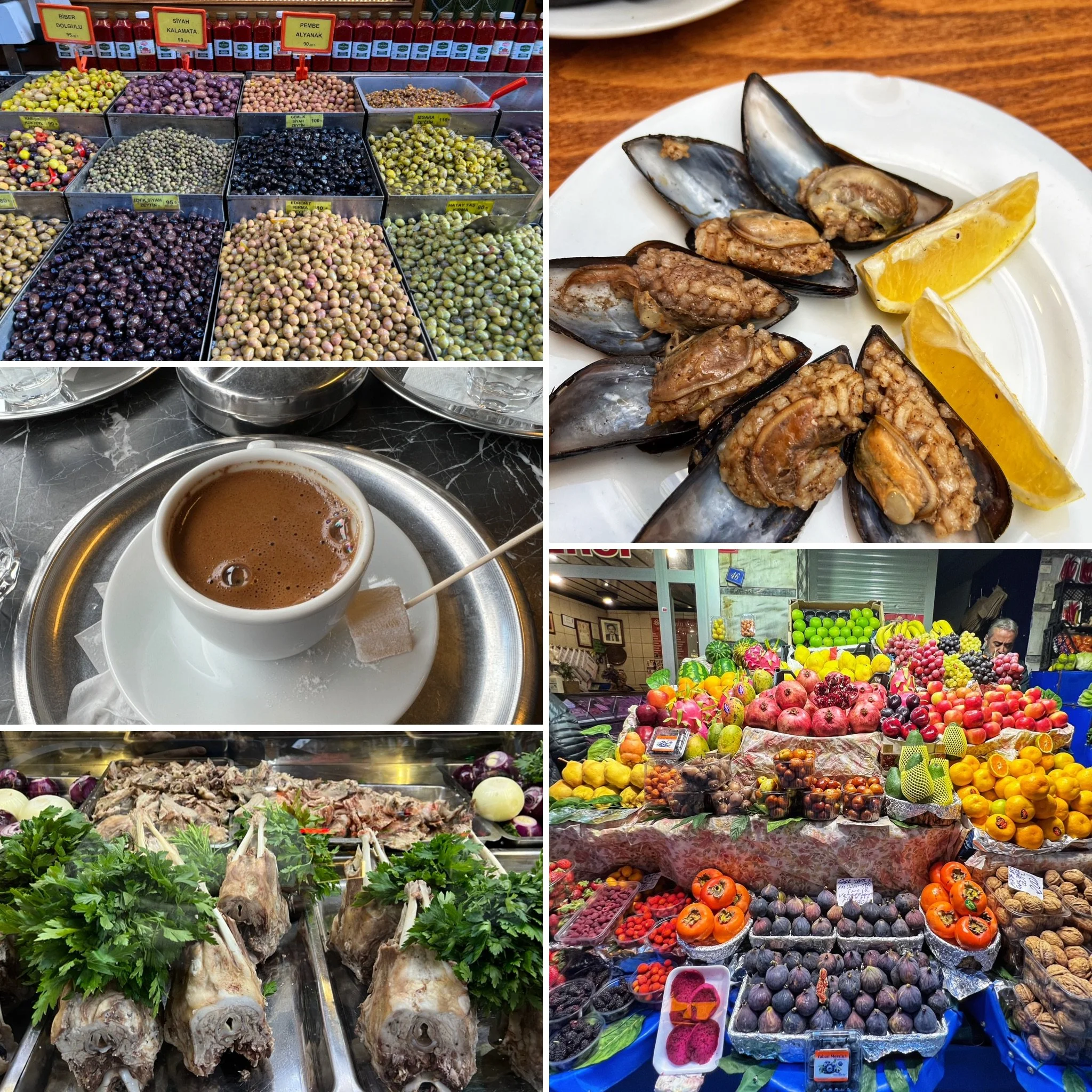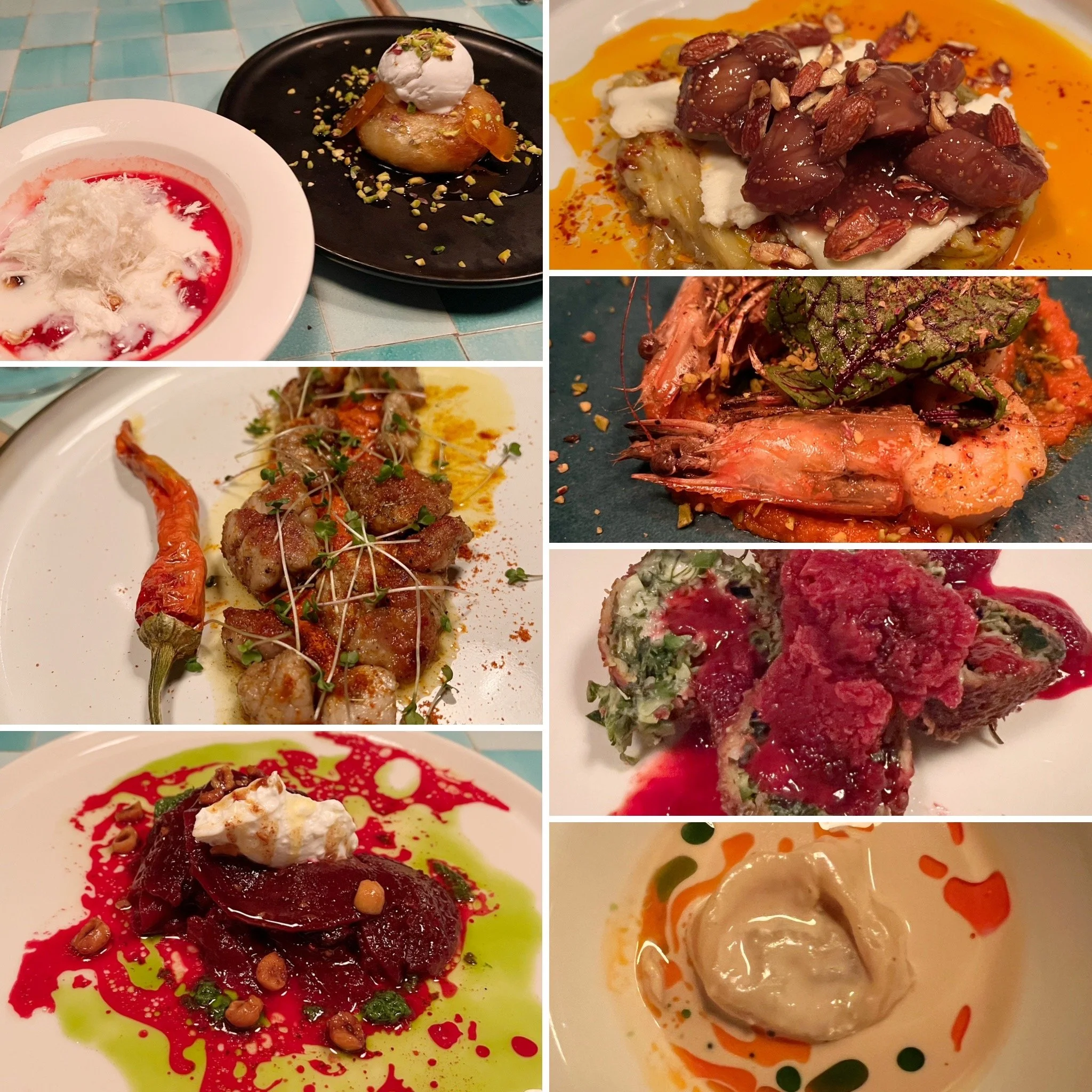7 Good Eats in Istanbul
In any other city, a mosque this grandiose would be the defining landmark of the city. In Istanbul, it’s just one of 3,000. Yeni Cami, or the New Valide Sultan Mosque, is a stately presence in front of the Spice Bazaar. On the other side is the Galata Bridge to Beyoğlu , which is lined with restaurants that at night transform into hookah and karaoke bars.
The second our cab breached the city limits of Istanbul, I was overwhelmed. From every bustling street corner to every sidewalk café, the city is vibrant and alive in ways that I’ve rarely experienced before. Even as someone who loves mega-metropolises like New York and Hong Kong, Istanbul buzzes with a different energy. I understood immediately how people get drawn to this city, with its historic mashups of culture and architecture, skylines of stately mosques and minarets, and good food every ten steps. The drivers here are fearless, the pedestrians even more so, and hustle culture is more of a necessity than a hashtag.
I won’t pretend I know anything about Istanbul. I was a mere transient visitor, a drop in the ocean of tourists that flock to this continent-straddling hub, granted access to only scant glimpses of the city in my too-short five days there. I took paid tours of Topkapi Palace and chuckled as our free walking tour guide tested the waters before railing against the current political climate. My only travel tip: now that the Hagia Sophia is a full-time mosque again, it is open 24/7 outside of prayer times, which means you can skip the hours-long lines during the day and just go in the evenings.
Instead, I just want to share a short list of seven things (and corresponding places) that we ate and loved, inspired by the City on the Seven Hills, recommended to us by locals whose eyes lit up when we asked about grilled offal and their favorite street eats.
Turkish BBQ
This is my favorite photo because it perfectly encapsulates our slight confusion as the proprietor brusquely organized a photo opp for us hapless foreigners and shoved a piping hot lamb shank in my hand. All the subsequent photos were of me trying not to grimace in pain. We were, of course, predictably delighted.
For meat lovers, there is no pleasure like sitting down for mangal, a feast of meats prepared on a mangal open charcoal fire. We were recommended Baran Et Mangal in the Fatih district, which is easily accessible by a number of public transportation options, including the M1 metro line. From any of the nearby stops, a breezy walk takes you there past the Aqueduct of Valens, a 4th century Roman aqueduct that now casually straddles a multi-lane road. If you’re not hungry by the time you get there, you’ll soon be salivating— the area surrounding Baran Et Mangal is filled with fragrant mangal and kebap shops, each with mouth-watering smells wafting from their open grills and roasting spits.
The menu is simple— there’s a small selection of salads and dips, and then there’s all the meat. You can order various cuts or sausages by weighed portions, or you can ask for a mixed plate large enough to feed your party. We did the latter and ended up with a glorious platter of chargrilled chicken breasts, lamb chops, lamb tenderloins, sausage, and a smoked lamb shank that the proprietor made me hold while he coaxed one of the servers to take an unprompted photo of us gobsmacked tourists. Hilarity of the moment aside, the meal was glorious. Everything was cooked to smoky perfection and despite our best attempts, we still ended up with a parcel of leftovers that we surreptitiously saved for some of the city’s adorable but well-monitored street dog population.
Kokoreç
A nicely toasted hunk of bread stuffed with a hefty portion of kokoreç. It’s not beautiful, but it’s good.
This is the street food that, upon asking various locals their favorite establishment, tended to open the most floodgates about their other favorite comfort meals. It’s basically lamb intestines wrapped around offal, either roasted on a skewer or chopped on a griddle with tomatoes, oregano, and chilis and served on or with a thick chunk of bread. There’s also the Izmir variation, which prepares the intestines in larger chunks and omits the tomatoes and spices. I think once people realized we were keen to eat kokoreç, it usually meant we were open to other foods too, so we’d get excited recommendations for other dishes like fat soup and boiled sheep’s heads (all very good; more on that further down!).
Almost everyone we asked recommended finding kokoreç along the alleys branching off from Istiklal Street, the busy pedestrian shopping street that runs through Beyoğlu on the northern European side of Istanbul. One of the shops we were directed to was Şampiyon Kokoreç, a casual joint that serves both styles of kokoreç along with a plethora of other tasty bites like stuffed or fried mussels. As an added bonus, it’s located on an alley filled with other quick bites, like grilled mackerel wraps and fruit stands. As for the kokoreç itself, both varieties were great, although by unanimous vote we preferred the Izmir style, which let the taste of the gently seasoned sweetbreads dominate more. It’s worth pointing out that if you’re not accustomed to eating animal organs, your mileage may vary, as it does have some of the slight bitterness and game you’d get from things like liver. But if you’re into it, then great! It’s a satisfying bite of slightly chewy, slightly greasy comfort that’s soaked up by the toasted bread. Try it washed down with a bottle of ayran, a salted yogurt drink served chilled.
Midye Dolma - Stuffed Mussels
A lot of the same street stalls and alleyway establishments that peddle kokoreç will also offer mussels served in a smattering of ways, including the beloved midye dolma—mussels stuffed with a mixture of spiced rice and herbs. Served with a few lemon wedges, they're like little briney bites of paella that you can shovel into your mouth by the shell-ful. Outside of Beyoğlu, they can also readily be found in Kadiköy on the Asian side of Istanbul. If you're on the European side, the easiest way to get there is to take the ferry, which drops you off a block from a bustling market district filled with everything from fish mongers and produce stands to pickle shops and specialty book stores. Direct your GPS to Güneşli Bahçe Sokak to find yourself smack dab in the middle of the market.
While you’re over there, make your way over to the Moda district for laid back cafes, international cuisine, hipster coffee joints, beer bars, and everything in between.
Pickled Vegetables
And speaking of pickles, while you’re in the Kadiköy Market, stop by Özcan Turşu, a pickle shop that has been selling pickled everything since 1935. While the outside display offers passersby bulk olives and bottles of pickling brine, the inside is lined with jars of just about anything that can be fermented or tossed in vinegar, from vegetables to fruit to eggs to fist-sized veggie parcels wrapped in chard stalks. If you can't decide what to buy, you can pay roughly $0.50 for a plastic cup full of whatever mixed pickles they're dishing out that day, floating in a spicy brine of what they proudly call "probiotic drink." It’ll also make you feel like a million bucks if you’ve spent all day cramming your face with roasted meats.
Beyran
Our hotel manager insisted that we make the trek out to Dürümcü Emmi, also located in Kadiköy, for their famous beyran. Don’t be deterred by the long line— the restaurant takes up multiple buildings and floors and has a remarkably fast turnover rate, probably because most of the patrons are there just to tuck into a steaming bowl of the aforementioned beyran. It was one of my favorite dishes during our entire stay in Türkiye, and one that I continue to dream about. It's made of rendered lamb fat that's mixed with rice and shredded lamb, then simmered with garlic, chilis, and bone broth. It is mind-blowingly good and feels like drinking a warm hug on a cold night. Yes, it’s as greasy as you would expect, but the garlic and spices temper the fat, and once you have a bite, it’s nearly impossible to stop eating it. The restaurant serves other dishes as well, but the beyran is a standout. It is well worth seeking out, and if you happen to be staying near Sultanahmet, you can just hop the Marmaray rail line back, which will take you under the Bosphorus Strait back to the European side.
Starting from the upper right and going clockwise: 1. Stuffed mussels, served with a squeeze of fresh lemon. 2. One of the many produce stands where you can get fresh, regionally-grown fruits and other goods. If you buy a bag of walnuts, they’ll crack them open for you on the spot so you can munch as you keep exploring. 3. Boiled lamb’s head from Beyoğlu Kelle Söğüş Muammer Usta. 4. Turkish coffee, of course. Fazıl Bey'in Türk Kahvesi brews a good, strong cup, and also offers versions with cardamom, mastic, or other spices. 5. Giant piles of olives outside of Özcan Turşu.
Kelle Söğüş - Boiled Lamb’s Head
A few steps away from the fish mongers and kokoreç stalls in Beyoğlu is a small corner restaurant with a handful of tables and a display case adorned with old photos of a wheeled cart—Beyoğlu Kelle Söğüş Muammer Usta. Established in 1890, the business has been in the family for four generations and only serves one thing—kelle söğüş, or boiled lamb’s head. The head is boiled until the meats and fats separate from the bone, then chilled. It’s then chopped and seasoned with chili flakes and other spices, then tossed with copious amounts of fresh parsley and raw onions, and served with slabs of bread. It’s delicate and mild, without any of the gaminess or grassiness people usually associate with lamb, brightened by the crisp raw onions. Like most of the other dishes we were recommended, it’s comforting, cheap, and immensely filling.
If you need something to chase your meal, the shop is close to plenty of produce stands where you can buy seasonal Turkish produce like mulberries, juicy figs, jujubes, and fresh walnuts the size of a golf ball. If you’d rather drink your vitamin C, juice stands are plentiful, with winter bringing delights like pressed-on-the-spot pomegranate juice for a dollar.
Upscale Turkish…
Okay, this one doesn’t really fit with the theme of my list, but whenever I travel, I try to sit down for an upscale take on local food to round out my experience. If you have the chance, please book a table at Yeni Lokanta in Beyoğlu for their triumphant multicourse tasting menu inspired by regional ingredients and traditional Turkish cuisine. Accessible by metro with a little extra hoofing, this cozy establishment near Istiklal Street manages to hit that sweet spot of hospitality-forward fine dining, making diners feel at home in a laidback atmosphere all while serving up one of the best meals I’ve had in years.
A smattering of the courses at Yeni Lokanta, including—starting in the upper right and moving clockwise— eggplant with goat cheese, figs, and nuts; prawns with carrot puree and chard; herb fritters with a sour cherry sorbet; a beef dumpling with a savory yogurt sauce; braised beets with dried sour cherries, hazelnuts, and Turkish feta; lamb sausage; and a dessert course with a tonka bean-flavored rice pudding with raspberries and sugar floss, and a katmer phyllo pastry with coconut ice cream.
Leaning heavily on seasonal offerings like sour cherries, carrots, beets, hot peppers, and copious spices, the menu is playful and thoughtfully crafted, with every taste or texture counterbalanced by the perfect complement. Our opening course was a Turkish beef dumpling (manti) served in creamy, savory yogurt sauces streaked with chili and herb oils. It was an amazing start to the meal, and when the server asked if we wanted seconds, we readily agreed. Another of my favorite dishes paired hot fresh herb fritters with a tart cherry sorbet. Yet another standout was a dish of fat prawns served atop a ginger and za’atar-spiced carrot puree, nestled around a bed of chard.
Best of all, it’s remarkably affordable for the dining experience you get, coming in at around $80 for nine courses—far less than what you could expect to pay in a more expensive city for this high caliber of food. You can also add on a wine pairing, which features Turkish wines from various regions and extremely generous pours.
If you’re somehow not stuffed after dinner, head up to Istiklal Street towards Taksim Square and pop into one of the many Hafiz Mustafa 1864 locations for a sit-down dessert or a quick take-out bag of their traditional Turkish delights. Unlike many of the cloyingly sweet stuffed Turkish delights you’ll see pushed at tourists in souvenir shops, Hafiz Mustafa uses traditional recipes for treats that are chewy and not too sweet. Their full dessert menu also includes fun dishes like chicken breast pudding (a mouthy Ottoman-era milk pudding with subtle strands of chicken breast), different varieties of baclava, crispy kadayif (cakes of finely shredded phyllo dough), and kunafa, which pairs the kadayif with a mild and stretchy cheese.
Honorable Mentions
Istanbul is full of quick, satisfying eats, and one I keep thinking back to is balık dürüm, or fish wraps. For just a couple bucks, you can get a toasty wrap filled with fresh-grilled mackerel, tomatoes, raw onions, and herbs. Find vendors near the fish mongers or down along the water by Galata Bridge.
For a country so famous for its coffee, not every cup is going to be good, unfortunately. But you can consistently get a terrific traditional Turkish kahve at Fazıl Bey'in Türk Kahvesi or Mandabatmaz. Try it with fresh-ground cardamom or mastic.
Ultimately, you could probably eat at a new place every day for years and not even scratch the surface, but these were some of our favorites of the places that were recommended to us. Do you have any favorites of your own? Drop a mention in the comments below!











